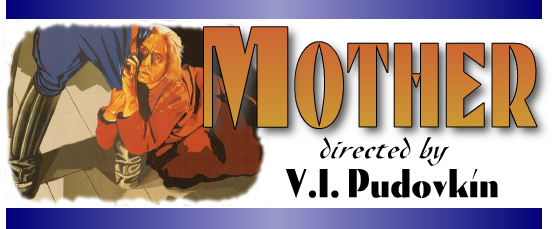

The same uncontrolled praise, inaccurate claims, and political bias surrounded Pudovkin's film "Mother" as were noted in the case of "Potemkin."
Approaching more warily, we have to record the general drab dreariness, the exaggerated characterizations (especially of the Boss Class), the tendency to run to length and the over-emphasis of the symbolism. These are not necessarily the fault of the director who had to convey clearly a political message to audiences not very deeply educated, but they detract from the artistic significance of the film. On the other hand, the film is unique in its sustained lyrical beauty, its remarkable montage containing many passages never yet surpassed, its excellent and thoughtful photography which is so perfectly in sympathy with the direction, and its quite exceptional coordination of material. In no other film can be found so many brilliant touches linking characterization and behavior with such appropriate cinematic methods of portrayal. It is clear that the material must have been set out in minute detail before production started, and it is a fact that Pudovkin spent several months on the montage. The extraordinary unity of purpose and perfect welding together of the production phases proves again the importance of the director having complete control.
V.I. Pudovkin, born in Penza in 1893, was educated in Moscow and met Kuleshov in 1920. Seeing "Intolerance" changed his disinterest in cinema to a very lively interest, and he joined the First State School of Cinematography. He acted, wrote, and assisted with directing until his first assignment, "The Mechanics of the Brain" (1925), a scientific documentary on Pavlov's work. During this production, he wrote and directed "Chess Fever," a topical two-reel comedy on the 1925 International Chess Tournament, wherein Jose Capablanca appeared to play a part due to creative cutting in the Kuleshov tradition.
Then Pudovkin directed "Mother," followed by "The End of St. Petersburg." His first talkie was "Deserter" (1933). The reader is referred also to his wholly admirable book, "Film Technique," and his second work, "Film Acting." His thoughtful approach to cinema, his research during 1920-1925, his interest in painting (which led to carefully studied photographic compositions such as the prison courtyard [reel 5] after Van Gogh), his scientific education, and, above all, his ability to learn from other films and to develop principles of film technique started by D.W. Griffith and Eisenstein - all these factors contribute to make Pudovkin an outstanding creative director (but we wish he would make a more light-hearted film) - and "Mother" is his most intimate and characteristic and perfect work.
(1.) The film opens with a powerful shot of a soldier on guard, symbolizing authority. The rest of the sequence is vague. A man is ejected from a pub in the dark - the low tonal values are appropriate but too obscure due to poor quality of prints.
(2.) CM.S. introduces the Mother, washing - three pots simmer. The son sleeps in the background. CM.S. introduces him. Poverty and squalor are suggested. There is no long shot. The father is introduced, lurching through the night, recognised now from (1). A blunt M.S. shows him in the doorway. He looks at the clock - blurred, it comes into focus. MIX to C.S. - an iron, doing service as a weight. The father takes and pockets it, then arranges a chair and climbs up to the clock. The Mother starts forward, restrains him . . . In close-ups her hands seize his coat, the chair tilts, the clock is wrenched from the wall. They fall, the clock is smashed. One little gear wheel rolls on the floor, comes to rest. The man snarls with rage. He strikes . . . cut just before the blow to the son darting up from bed. The men grapple, the son is flung away, but seizes a hammer. High angle C.S. of him is finely contrasted with dramatic low-angle C.S. of the father. Then in C.S., his clenched fist relaxes, and he turns away. Outside he stumbles off, pausing to look at the iron . . . while, in high angles mid-shot, the rough boards forming the entire background, the Mother collects the wheels of the smashed clock.
(3) Title IN THE PUB is followed by a good establishing long shot, then detailed CM.S. of a band, consisting of three energetic accordion players, each of whom then gets a C.S. (one is sweating, one winks, one is stolid). Close-ups of fish, a drunken head sprawled on a table, glasses of vodka held in shaking hands - all are revoltingly explicit. Introduced by a title and C.S. is a wad of notes. The factory foremen are at a table together; their leader speaks emphatically. A strike is threatened. It will be stopped. He smashes a bottle on the table (ruthless force will stop the strike). The others munch fish and drink in unconcerned agreement. The band plays on. The father lurches in and up to the barman - asks for vodka in exchange for the iron - gets threatening on being refused. But the foremen see a chance to use him, so they supply vodka. Amid money, drink and music (shown well in superimposed M.S.), he sells himself to them.
(4) Feet tramp through mud. It is a girl, with a parcel. She goes up to a window, taps. The son looks up, joins her, takes the parcel ("not safe at our place any longer"). He takes her hand for a moment. In a lovely full C.S., she looks after him when he has gone. Then she hurries away. The son tiptoes in, hides the parcel under a floorboard - but, drowsily (indicated by irised shot of varying focus), the Mother has seen. Slow fade-out. (End of reel 1).
(5) Mist rises over still water; the early sun streams through.
Fleecy clouds fill the sky, cock crows, blossom is on the trees.
Two men join a group in a dell - the Strike Committee. Natasha
says she, too, will go to the factory. The leader makes the key
statement . . .
(a) C.S. He speaks. . .
(b) TITLE: "Remember -"
(c) CM.S. Some of the committee - they wait on his words. . .
(d) C.S. (as a) he speaks . . .
(e) TITLE ". . . at ten o'clock all the wheels will stop."
(f) C.S. (as a) he finishes speaking
The split title gives greater emphasis (the second part is awaited by the audience) and permits more rapid cutting in keeping with the restless rhythm of the sequence. They all disperse, the men one way, Natasha the other.
(6) A complex series of mixes introduces the factory - steel
girders, chimneys, cables, and office buildings merge one into
the other in a horrid jumble which the present writer 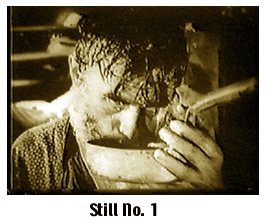 cordially
dislikes. A man pins a strike notice to a wall. The factory siren
blows. Men in the workers' tenements stagger up from their crude,
tiered straw beds. The Mother is pouring cold water over the father's
head till he grabs the can and drinks (Still No. 1). One of the
strike-breakers calls, says, "Go quietly to your work."
cordially
dislikes. A man pins a strike notice to a wall. The factory siren
blows. Men in the workers' tenements stagger up from their crude,
tiered straw beds. The Mother is pouring cold water over the father's
head till he grabs the can and drinks (Still No. 1). One of the
strike-breakers calls, says, "Go quietly to your work."
(7) A high angle general long shot, looking into the main gates of the factory and showing the gateman on his stool and part of the shops within, is followed by C.S. of a weedy and ill-shaven young man with shifty eyes. In a warehouse is a tough gang with sundry weapons. "Blacklegs," reads the title - more correctly "strikebreakers." The father is led in; he is one of them.
(8) TITLE: "The strikebreakers get ready" is followed
by the long shot referred to above, but now the gang of strikebreakers
are within the factory. One tells the gateman to go. He refuses,
so the manager is sent for to give the order. He has a brisk gait
and evokes much hat-doffing. In striding away he pauses, glances
at his watch. Getting out of the way of trouble is curiously implied.
Two of the strikebreakers take up positions behind the massive
gates. The main gang is dispersed to nearby shops in the same
long shot as (b) below. Then . . .
(a) TITLE: The trap
(b) L.S. A lad runs to the gate from outside,
(c) CM.S. whistles with two fingers in mouth, then yells
(d) TITLE: "They're coming out!"
(e) C.S. Face peeks round one of the gates.
(f) L.S. (as b) Lad sprints like blazes to take cover in one of
the shops.
(g) C.S. (s e) Face withdraws,
(h) L.S. (as b) Strikers walk into factory; gates are slammed
behind them.
(i) M.S. They turn, puzzled.
(j) TITLE: "What's up?"
(k) C.S. Bolt is shot at home.
(l) L.S. They talk among themselves. From all directions the strike-breakers
stroll up.
The wording of title (d) is obscure as, in fact, the strikers are entering the factory. Then the foreman (strikebreaker) asks "Taking a holiday?" and is knocked down - crisply cut blow - then a three-frame shot as he rolls on the ground. The son pushes to the fore, is seized, papers dragged from him (presumably strike notices) and scattered. His eyes meet his father's. Then, amid a hail of missiles, the strikers escape.
(9) The escape is concentrated on the son and one other
man. Several long shots in corners of the factory show the pursuit,
(Still No. 2), and they get over the wall, but only 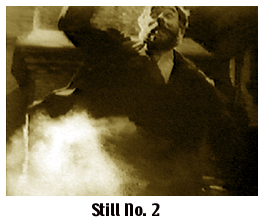 after
a struggle, for the father grabs the son's legs as he is getting
over, but is kicked away. They rush into the pub. The son gets
through, but the barman catches the other. The pursuers break
in; the youth threatens with a gun, but bottles are flung at him,
and hands seize him from behind . . . CUT to four serene shots
of lofty trees, bright clouds, rippling water. The son runs on
along. Then back to the pub - the roughs move away, and we see
the youth laid out, torn and bleeding - detail, jagged bottle
in one hand. Another still figure is also on the floor - the father.
after
a struggle, for the father grabs the son's legs as he is getting
over, but is kicked away. They rush into the pub. The son gets
through, but the barman catches the other. The pursuers break
in; the youth threatens with a gun, but bottles are flung at him,
and hands seize him from behind . . . CUT to four serene shots
of lofty trees, bright clouds, rippling water. The son runs on
along. Then back to the pub - the roughs move away, and we see
the youth laid out, torn and bleeding - detail, jagged bottle
in one hand. Another still figure is also on the floor - the father.
(10) At the striker's H.Q., the son explains his escape. Natasha is calmly seated. A man paces up and down behind . . . (End of reel 2).
(11) The Mother kneels praying. In getting up she dislodges the loose floorboard and, thinking back (the irised shot is repeated as a flashback), she looks and finds the pistols. Feet approach . . . she hears and frantically rewraps and conceals the guns in a fine fringed high-angle shot. Then we see struggling feet, and two other still feet, and realize what is the burden . . . They lay down the father's body . . .
(12) A drum is struck; feet and bayonets flash past, Title: LAW AND ORDER . . . the military enter the factory . . .
(13) A candle burns at the father's head. The Mother sits, watching, by the body. Two mourners pay their last respects. The Mother sits, expressionless. Left alone, she thinks about the guns. (A series of mixes).
(14) A comrade warns the son, "Get rid of the guns."
(15) Soldiers, led by an officer, set out - through mud . . .
(16) Still the Mother sits. The candle burns steadily. Water drips into a dish. In L.S. the door opens, the son enters, realises, sits down uneasily on his bed . . .
"Who killed him?" . . . "Your side."
He lies by the still candle. The water drips. Both Mother and
son think uneasily about the guns beneath the floorboards. The
C.S. of the loose board becomes fraught with tension. Then . .
.
(a) L.S. (Mother and father's body in background) Son goes to
the loose board . . .
(b) C.S. Mother exclaims in horror. MIX TO
(c) C.S. The guns (b and c total 17 frames)
(d) C.S. Hands clutch at clothes (8 frames)
(e) CM.S. Father's body. (3 frames)
(f) CM.S. Father's body (different angle) (5 frames)
(g) C.S. The son. MIX TO
(h) C.S. The Mother moves forward. . . (g and h total 22 frames)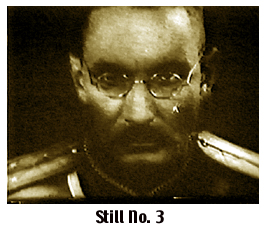
And struggles with him in terror till a hand thumps on the door. A youth bursts in . . . laconically states, "Soldiers." (Youth's name is Pavel. He can be distinguished shouting this name when the son cries, "Who's there?" both being in C.S. without titles). Then, led by the strikebreaker previously associated with the father, soldiers march in followed by a mild officer (Pudovkin plus moustache). The candle flame flickers by the father's head. In M.S. the Mother looks on in horror. The officer carefully wipes his spectacles - sees body - they all uncover. One soldier belches, another fiddles with his belt. Tension is worked up in close-ups of the son, Pavel, the Mother, and the officer (Still No. 3). No one replies to the demand to disclose the guns. The order is, "Search the house." Officer lights cigarette.
(17) A strikebreaker has gone to military H.Q. - reports having found the son. The factory owner and a superior officer are there. The latter decides to go and make an arrest - magnificently shown in detailed C.S. of his hand reaching for gloves and hat . . . fade out.
(18) The search is over. The officer throws away his cigarette, and all leave. Joyfully the Mother bows them out. (Her expression would have given the game way even to a nit-wit stupid enough to overlook the obvious loose floorboard in searching the house!) Outside, they meet the superior officer. All re-enter. Then, a dramatic start to a magnificent sequence . . .
(a) C.S. The son and Pavel talk. Pavel smiles, then his
smile freezes . . .
(b) L.S. Soldiers enter.
(c) CM.S. The Mother anxious.
(d) C.S. (low angle) The new officer (Pudovkin remains in background)
(e) L.S. (as b) Officer points at the son . . .
(f) C.S. arm swings up, pointing . . .
(g) TITLE: "Arrest him."
(h) C.S. (as f) arm swings . . .
(i) L.S. (as b) . . . down again. Mother rushes to son . . .
(j) CM.S. . . . up to son, cries out . . .
(k) TITLE: "Why?"
(l) CM.S. (as j) She is terrified.
(m) C.S. (low angle)the officer replies. (Still No. 4)
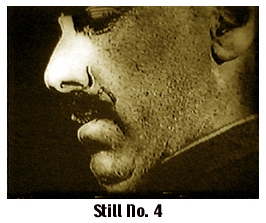 (n) TITLE: "Because he hasn't
given up the guns."
(n) TITLE: "Because he hasn't
given up the guns."
(o) C.S. (as m) he says.
(p) CM.S. (as j) the mother still hopelessly clings . . .
(q) C.S. (hands only) . . . to the son, and they push away . .
.
(r) CM.S. (as j) . . . a soldier.
(s) M.S. The soldier is pushed away.
(t) C.S. (low angle) Officer speaks, roughly.
(u) L.S. (as b) More soldiers rush over to Mother and son.
(v) C.S. (as t) Officer speaks roughly.
(w) C.S. Hands roughly seize son.
(x) C.S. Son, struggling.
(y) M.S. Son, struggling.
(z) L.S. *(as b) Mother runs up to officer.
(aa) C.S. (as d) He looks down at her.
(ab) C.S. She appeals.
(ac) TITLE: "I will give you the guns if you let my son go
free."
(ad) C.S. Officer replies
(ae) TITLE: "Hand it over."
(af) C.S. (as ad) he says,
(ag) C.S. (as ab) she excitedly turns.
. . . but the son is filled with despair. She gets the guns and hands them over, and the son is rewarded by a blow across the face (as superb C.S. follows, his burning eyes biting into the camera, a trickle of blood from his mouth). Then both are dragged away. The Mother is left alone, prostrate with grief and despair. (End of reel 3)
(19) MANY MONTHS LATER. THE TRIAL. These titles are followed by a shot of the wintry sun, then a series of mixes of the impressive masonry of the Court, admirably done, symbolising cold justice. A policeman is on guard. Escorted, the prison carriage drives up. The son and Pavel alight. The son smiles in the radiant sunlight, but he is jostled on, up the wide steps, inside.
(20) Early, the Mother sits miserably alone. But gradually the benches fill up. The solicitor and the prosecutor enter. Meanwhile the judge is robing with slow elegance while discussing horse flesh with his debonair fellow justices. They enter the court; the prisoners are led into the dock. The judge sits with stern alertness. The charge is read at length. A woman in the court looks pleasurably round at the Mother, the prisoner, and the judge and revels in good justice . . . and remarks, "He will certainly be sentenced." Justices look at their watches and sketch horses. Solicitor hiccoughs; he is either drunk or painfully nervous. Prosecutor declaims, pointing. Camera set-ups include painting in background indicating legal ancestry. The defending solicitor speaks haltingly with nervous incompetence. After a short recess, court returns to pass sentence. Tension is worked up with intercut close-ups. Natasha nervously fidgets. The sentence . . . PRISON. Vividly, in back-lit close-up, the Mother cries out. Others quietly relax, the show being over.
(21) The Justices comment smilingly on the affair. There is a crowd outside as the son is led down the wide steps. But the Mother bursts through, fights her way to him, crying . . . "Forgive me, my son." She is dragged away. He, pushed forward to the prison van.
(22) TITLE: "Natasha explains to the Mother." This short sequence is done entirely in close-ups. The girl's hands caress those of the Mother. The loose floorboard is used again to conceal papers. A handshake. A departure - another understanding holding of hands. (End of reel 4).
(23) Prison is symbolised by one soldier on guard in a very strong low angle picture, black against a clouded sky. A key is turned in a lock. The son emerges from the gloom. By a grille, the Mother sits waiting. She steals a glance at a note she holds crumpled in her hand. The son appears (in prison clothes hopelessly too big for him), and they meet at the grille. They stand very close. The warden dozes. The armed escort watches a beetle crawling out of a dish of food. They manage to touch hands to pass the little note. The Mother smiles tremulously. "Forgive me, my son" . . . the son smiles, laughs; the Mother laughs in response. The guard laughs also and pushes the beetle back into the food. The warden calls, "Time's up." The son is led back. The mother half smiles, half cries (Pudovkin copying from Griffith's effect with Marsh and Gish).
(24) AND OUTSIDE . . . sparkling running water . . . SPRING
. . . water, ducks, children at play. The Mother walks home. The
son, cautiously, lest he be observed through the spy hole, reads
the note . . . "The lamplighter will put a ladder against
the wall. At 12 o'clock there will be a cab waiting at the corner."
The depicting of the son's joy at this note is remarkable.
(a) C.S. his eyes (9)
(b) M.S. he sits in the dim cell. (32)
(c) C.S. rushing water. (11)
(d) C.S. rushing water. (12)
(e) C.S. rushing water. (8)
(f) C.S. rushing water. (6)
(g) C.S. rushing water. (8)
(h) C.S. rushing water. (13)
(i) C.S. son's hand grips bench. (25)
(j) C.S. his chest heaves (37)
(k) CM.S. sparkling surface of rippled water (39)
(l) CM.S. similar to (k) (14)
(m) C.S. (low angle) a laughing child (38)
(n) CM.S. (as k) (14)
(o) CM.S. (as l) (13)
(p) C.S. (as m) (27)
(q) CM.S. a splash in the water (33)
(r) CS. (as a) the son's eyes (11)
(s) C.S. sparkling water (14)
(t) M.S. (as b) he gets up . . . (16)
(u) CM.S. . . . to is feet. (13)
(v) C.S. tin mug. His hand grabs it . . . (9)
(w) C.S. . . . he swings it . . . (5)
(x) C.S. (new angles) . . . swings it . . . (21)
(y) C.S. . . . it bounces on the floor. (6)
(z) CM.S. . . . it bounces . . . (10)
(aa) CM.S. . . . it bounces again . . . (18) (cf. "Potemkin,"
end of reel 1)
(Numerals in brackets denote number of frames in each shot.)
Then the warden looks up, but the son dances a jig in his exuberance.
(24) TITLE: "In the common cell" . . . one prisoner talks earnestly; others gradually crowd round to listen. Intercut close-ups of these men, admirably chosen types, show their thoughtful attitude. TITLE: "na svou práci" (meaning . . . "in his thoughts" . . . one frame only appears in the prints available, the poor, forlorn, unredeemed flash title of the original imported negative!) The pastoral shots are good - no, excellent. Then comes a shot of ploughing, and a hand in C.S. crumbles the good brown earth . . . fade-out. The same hand belongs to one of the thoughtful prisoners. Then "tomorrow during exercise" is flashed amongst them . . . missiles are prepared . . . eyes watch furtively . . . tapping message, "TOMORROW DURING EXERCISE."
(25) TITLE: "In the factory" . . . a group stand talking . . . TOMORROW . . . the foreman sees, passes by.
(26) TITLE: "and in the town." Horse-carriage draws up. An officer alights and is ushered into the presence of his superior.
(27) Prison introductory shot is repeated (see 23). The son reads a new note, "Everything is ready for your escape. Tomorrow you will be free again. They are coming from all parts of the town."
(28) Long shots establish the frozen river and the factory. Men move in groups enthusiastically. The idea "something's up" is strongly conveyed. From behind a pile of building material the foreman watches . . . The Mother chances to walk past a woman feeding her baby. She smiles. "A son?" The other looks up with radiant pride; the child turns its head. "Yes, a son." Crowds walk on the streets of the town. The spring water runs. On the wide river the ice is breaking. The floes are moving slowly. The crowd proceeds, the Mother with them. The son climbs and looks out of the prison window - sparkling and swirling water rapidly intercut in short flashes, vividly expressing his turbulent joy.
(29) The bell is rung for exercise. At the corner, as arranged, Natasha waits with the cab. The son looks from the window and sees in the distance (circular mask) the ladder being placed in position. The warden hammers at this cell door. Too late he obeys and drops down from the window. He is to lose his exercise.
(30) A superb (Frtiz Langish) long shot establishes the prison yard. The file of prisoners starts. Cutting back to the long shot, they enter in the far background - the arrangements being of exquisite perfection. (The ice floes move on, the gathering crowd marches on, lad smiles, waves, gets a cuff on the head from his boss-class father). A message is brought in haste. The exercise continues, the men walking in a huge oval. Guards overlook the yard. A brick lying on the ground is gradually kicked into line by successive men and finally picked up. (End of reel 5)
Messenger enters, hands over note. "Stop the break
at once," signed by Chief of Police. Crowds march along.
Military H.Q. are informed. Bugle call is given. Soldiers double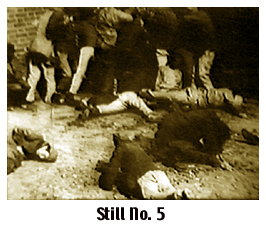 out, cavalry mount. Bridge spans the river.
Against the piers, the ice floes slowly crumble. But the ice drifts
inexorably on, and the crowd presses inexorably forward. The Mother
is among them. The red flag is passed along to the front, held
aloft. The ice sweeps on. The bridge spans the river. The exercise
is stopped. But the missiles are ready, and when the protests
from the prisoners are ignored, they let fly, and rush away in
a mob. Those still inside the prison smash up furniture for weapons.
The son desperately batters on his door. Many escape down the
stairs. Outside they start to scale the gates, but the soldiers
arrive; many are mown down (Still No. 5). More prisoners escape.
The warden enters the son's cell, is hurled out and down into
the well of the huge building. Flash shots of rifles firing. More
soldiers turn out. More prisoners pour down the stairs. At last,
some reach and climb the wall, the son among them. One reaches
the cab and is whirled away. The son looks over the river . .
. the ice is breaking up . . . wardens appear with rifles . .
. he dashes on, leaps from floe to floe as they fire on him. He
is a tiny black speck on one small island of ice, but collapses,
exhausted. The crowd marches on, flag flying. The ice floes are
relentlessly split and broken at the pier of the bridge. The red
flag flies bravely. The bridge. The ice piles up; the son clambers
up. An order is given to the cavalry. They set off, advance across
the bridge. (The stately direct angle is spoiled by a cut-in diagonal
shot in which the girder-pattern obtrudes.) The son hurries to
meet the crowd. He at once occupies the centre, but the Mother
forces her way up to him and locks her arms around him. The soldiers
dismount, advance with their rifles. The crowd realise in terror.
The signal is given. A volley of fire. Dashing feet, collapsing
bodies. One desperate scream, and the son's eyes are closed. He
sags, and pulls down his Mother on to him. She cries out as she
sees the blood on his forehead. And then she takes the flag from
the mud, stands erect, holds it and keeps it flying. The cavalry
charge. There is a storm of beating hooves. They charge right
at her. She is trampled down. And in spacious long shot, the crowd
wildly disperse, as she lies alone in the mud by the flag.
out, cavalry mount. Bridge spans the river.
Against the piers, the ice floes slowly crumble. But the ice drifts
inexorably on, and the crowd presses inexorably forward. The Mother
is among them. The red flag is passed along to the front, held
aloft. The ice sweeps on. The bridge spans the river. The exercise
is stopped. But the missiles are ready, and when the protests
from the prisoners are ignored, they let fly, and rush away in
a mob. Those still inside the prison smash up furniture for weapons.
The son desperately batters on his door. Many escape down the
stairs. Outside they start to scale the gates, but the soldiers
arrive; many are mown down (Still No. 5). More prisoners escape.
The warden enters the son's cell, is hurled out and down into
the well of the huge building. Flash shots of rifles firing. More
soldiers turn out. More prisoners pour down the stairs. At last,
some reach and climb the wall, the son among them. One reaches
the cab and is whirled away. The son looks over the river . .
. the ice is breaking up . . . wardens appear with rifles . .
. he dashes on, leaps from floe to floe as they fire on him. He
is a tiny black speck on one small island of ice, but collapses,
exhausted. The crowd marches on, flag flying. The ice floes are
relentlessly split and broken at the pier of the bridge. The red
flag flies bravely. The bridge. The ice piles up; the son clambers
up. An order is given to the cavalry. They set off, advance across
the bridge. (The stately direct angle is spoiled by a cut-in diagonal
shot in which the girder-pattern obtrudes.) The son hurries to
meet the crowd. He at once occupies the centre, but the Mother
forces her way up to him and locks her arms around him. The soldiers
dismount, advance with their rifles. The crowd realise in terror.
The signal is given. A volley of fire. Dashing feet, collapsing
bodies. One desperate scream, and the son's eyes are closed. He
sags, and pulls down his Mother on to him. She cries out as she
sees the blood on his forehead. And then she takes the flag from
the mud, stands erect, holds it and keeps it flying. The cavalry
charge. There is a storm of beating hooves. They charge right
at her. She is trampled down. And in spacious long shot, the crowd
wildly disperse, as she lies alone in the mud by the flag.
The rhythm of this final episode is worked up to a fever of dramatic cutting at the moment of the charge. Tracking shots of the advancing horse are taken from on horseback, terrific vigour being imparted by the impression of the spectator being actually amongst the riders.
(31) The film then ends with an epilogue (about 1.25 minutes) of stately ramparts and towers, in elaborate mixes, leading up to a grandly impressive shot of the red flag flying from a domed tower. Then C.S. of the flag, the shining sun immediately behind it. . . The End.
SCENARIO: Apart from its excellence in detail, the whole form of the scenario is a model of construction. Jay Leyda has pointed out that a sonata outline was consciously established, thus - sequences 1-10, allegro; 11-16, slow adagio; 17-23, allegro; 24-31, presto with crescendo to climax. This fundamental establishing of the tempo of the film contributes largely to the memorable rhythm of "Mother."
TITLES: There are only 86, and the majority of these have less than four words. Pudovkin was conspicuously successful in avoiding the titling errors made by Griffith and Eisenstein.
DIRECTION: The response from the players, both actors and natural types; the obvious selection of the right material to afford film strips suitable for the already-planned montage; the general high plane of all production phases and absence of incongruities - these are the best tributes to the remarkably profound direction.
PHOTOGRAPHY: The Courthouse exteriors were the first scene shot. The composition of the low angle shot of the policeman is after "Bollo" by Velasquez. There is much subjective camera work, as in reel 5 when the Mother talks to the woman feeding her baby. There are also very successful (directorial) effects as follows:
(a) "Camera as observer rather than mere spectator,"
e.g. camera on horseback in reel 6.
(b) "Pictorial sense of smell," e.g., detailed close-ups
in Pub, reel 1.
(c) "Pictorial sense of feeling," e.g. son struck by
Superior Officer, reel 3.
(d) "Pictorial sense of sound," e.g. dripping of water,
reel 3. (cf. icicle in "Pitz Palu")
MONTAGE: "Expert cutting on human movement" .
. . the tense turbulence of the latter half of sequence (2) is
the best example.
"Associative editing of unrelated scenes" . . . the
laughing child, swirling water, in quoted excerpt from reel 5.
"Linkage method of cutting" . . . derived from Griffith,
this is notable in the gathering of the crowds in reel 6.
There are also the remarkable "extraneous" shots, e.g.,
of serene trees, cut in at a moment of strife, giving a peculiarly
strong sensation by contrast.
ACTING: Baranovskaia and Batalov were brought from the Moscow Art Theatre. Tchistiakov was a studio accountant. The Superior Officer was formerly a Tzarist Army Officer. Pudovkin always played a small role in his films.
GENERAL: The few examples quoted from this exceptionally perfect film will both guide the interested student of cinema in looking for the many more contained in it, and also emphasise the remarkable brilliance of its director.